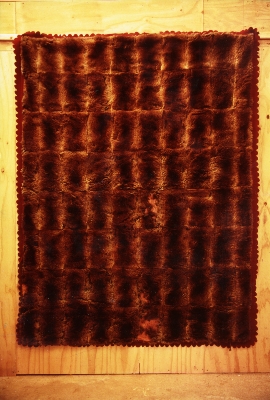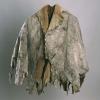Quilt No.173BM - Robert O'Hara Burke Memorial Museum
Owner:
Robert O'Hara Burke Memorial Museum
Location:
VIC North East
Maker
Maker:
Unknown
Made in
AUSTRALIA VIC
Patterms
Date:
1921 - 1940
Description:
Animal skin rug made from skins of the Long-footed Potoroo, the skins trimmed to rectangular shapes then stitched together. Backing and edging is of dark red felt.
1800 x 1500mm
History:
Maker unknown. Clive Crocker, the owner, found the rug in a box where he worked in Melbourne in the 1930s . Clive and Joyce Crocker lived in Beechworth. Donated to the Burke Museum, Beechworth (VIC) in 1982.
Story:
Corresondence from Burke Museum:
"The rug had been acquired by Clive through his work. In the 1930s he worked for a carrier in Fitzroy (Melbourne) and the rug had been found in abox where he worked, he kept it for many years and had finally decide to donate it to the Burke Museum in 1982."
The rug was originally thought to be made from possum or bandicoot skins. In 1998 the Victorian Department of Natural resources identified the hair as potoroo, and DNA testing confirmed the skins were those of the Long-footed Potoroo
Related Quilts:
Kangaroo skin cloak of seven gores is made from the skins of seven grey kangaroos (Macropus fuliginosus). The skins vary in size and shape, the inner five are roughly triangular. The cloak is edged with a series of loops, through one of these near the collar is a piece of cloth which appears to have tied the cloak together. The skins are sewn together with two sorts of linen or cotton thread. In a small diamond-shaped gusset at the back of the neck there are some stitches of sinew. The skins are sewn together by means of a small hem which was turned back on to the fur, so stitches went through two layers of skin on each gore. There are some small holes in the skins. The skins are very soft and pliable, and greyish in colour; they vary in size and shape.
Longest part: 800mm
Ref: MA Thesis 1973, S.Meagher 'A Reconstruction of the Traditional Life of the Aborigines of the S.W. of Western Australia.
Small possum skin rug with the centre area greyish skins and 2 narrow borders of reddish brown and dark brown pelts. The skins are hand sewn with white thread. The backing is woollen material, light brown with dark brown woven stripe.
1380 x 1040mm
Possum skin rug with 6 rows of 7 skins. The backing is red felt with a border showing and peaked edge.
1680 x 1460mm
Skin rug made from approximately 50 fox skins. These are hand sewn together in strips approx. 100mm wide across the width of the rug. Backing is of dark brown felt. The edge is trimmed with blue felt with a scalloped edge. Skins were tanned with wattle bark tanning solution.
1550 x 1300mm
Opossum pelts cut into rectangles and joined. The top is piped in red felt and the backing is red felt with a double scalloped edge.
1640 x 1210mm
Platypus skin rug, 63 pelts in 7 rows by 9. Skins are small, rectangular and worn down. The colour is greyish brown with a darker centre. The skins are machine stitched then the rug is hand sewn to dark brown felt which extends to form a wide border and this has 3 rows of machine stitching.
1780 x 1425mm








